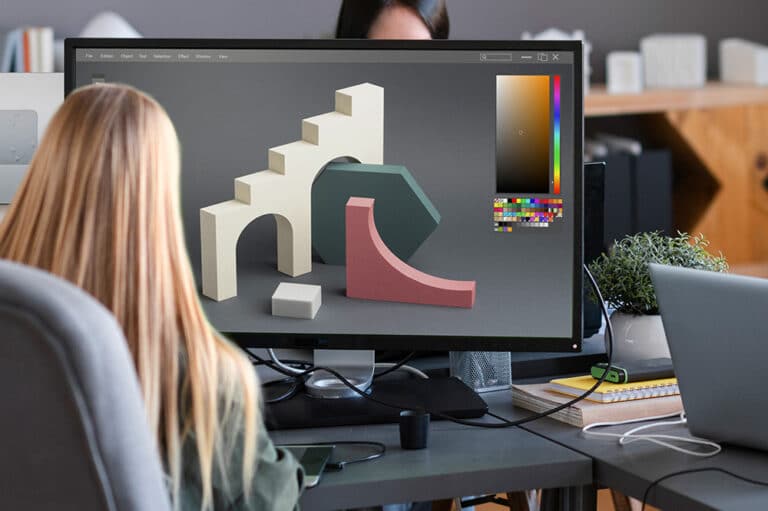How to become a graphic designer in 10 simple steps

Becoming a graphic designer is not as easy as one might think, as it involves a lot of work and dedication, but ending up being able to make a living from your creativity is totally worth it.
I have been working in the field of graphic design and creativity for more than 15 years and I have trained and managed dozens of graphic designers and I always perceive a lot of confusion around this topic. That’s why in this article I have described the 10 most important steps to follow to become a successful graphic designer.
Just remember to always stay dedicated and never give up, because with a little hard work, you can go a long way in graphic design.
1. Learn the foundations of Graphic Design
If you’re interested in becoming a graphic designer, it’s important to learn the foundations and principles of Graphic Design. You’ll need to learn about typography, color theory, and composition, and how to use those elements to create effective designs.
You’ll also need to develop a good eye for detail and learn how to use various design software programs. But if you’re willing to put in the work, studying graphic design can be a very rewarding experience.
You should also seek to understand the graphic design market and its possibilities. What types of graphic designers exist, what are their responsibilities, how much do graphic designers make, etc. in order to properly decide how to approach your graphic design career.
2. Study Graphic Design
This is the one of the most important steps to become a graphic designer. Without a proper education, it will be very difficult to find success in this field. There are many great online courses and schools out there that offer fantastic graphic design programs, so do your research and find the one that is right for your interests.
Get a degree in graphic design
Studying a graphic design degree guarantees you an education from accredited professionals. In addition, the teachers or instructors will often advise you and help you build a solid and attractive portfolio for companies that need graphic designers. You should keep this in mind, as creating an outstanding portfolio is a key step in getting a job.
Schools can also help you find and get an internship since many of them have agreements with some of the best design companies and agencies. Internships are a great way to get your foot in the door, gain some real-world experience and build your network.
Internships show creative directors more about you, the way you work and your attitude than a portfolio. That’s why talented interns often receive full-time job offers after just a few months of graduating. So if you can find a good internship, it’s definitely worth your while.
Study Graphic Design online courses
Many people don’t have the time or money to go to a traditional school, so they turn to online courses. There are many great online learning platforms like Domestika, Crehana or LinkedIn Learning, and they can be a great way to learn the basics of graphic design.
Courses are usually very affordable and you can often work at your own pace. In addition, you sometimes have the advantage of being able to ask questions to the instructors. They often also have forums or groups where many students are willing to help with questions and even collaborate on new projects.
So if you are interested in learning Graphic Design your way or just want to get an idea of what it’s like before making a major investment in a degree, online courses can be a great option for you.
3. Get the proper Graphic Design tools and equipment
To get into graphic design these days it is essential to have certain equipment, tools and accessories. Better tools won’t make you a better designer, but bad tools can limit your potential and the rate at which you improve your skills. Consider at least the following tools, which you are sure to need:
A good Computer
A good computer is essential for any graphic designer. You’ll need a computer that is powerful enough to run design software programs, and it’s also helpful to have a large monitor, so you can work comfortably. Check our guides on the best Macs for Graphic Design and the best laptops for graphic designers.
Professional graphic design software
Design software is another essential tool for any graphic designer, and employers expect you to use them effectively. The most popular software collection, and the one I recommend learning, is Adobe Creative Cloud, which includes programs such as Adobe Photoshop, Illustrator, and InDesign. But there are other really reliable software collections like the ones from Affinity or Corel.
Design accessories
Most of the time you spend designing, you’ll be surrounded or directly using office accessories such as graphics tablets, keyboards, office chairs, lamps, laptop stands or even drawing pens. Choose well the things that you will use a lot or that can affect your ergonomics, because that can have an impact on your productivity and your health in the long run.
A good camera
Carrying a camera is essential for any graphic designer. Carrying a camera with you allows you to capture the things that inspire you and also take high quality photos that you can use in your designs.
It doesn’t need to be a fancy camera, it can be your phone camera, but at least make sure it’s a good one. Personally, I find that the iPhone camera gives the best results in different situations.
4. Create a graphic design portfolio
A Graphic Design portfolio is an essential tool for any graphic designer. It’s basically a collection of your best work that showcases your skills and talent. It’s also a way to show potential employers what you’re capable of, so it’s important to make sure your portfolio is top-notch.
There are many different ways to create a graphic design portfolio. Some designers choose to create a physical portfolio that they can take to job interviews, but in my experience, this is in disuse, so I recommend going digital.
A digital portfolio can be viewed online, is easier to organize and update. There are platforms that allow you to publish your work for free, like Behance, and they don’t have any limit on the amount of work you can publish.
That said, at first I recommend that you post no more than ten examples of your best work, only the ones that best highlight your skills. That will force you to be selective. Next, write a brief description of each project to help the viewer understand your project and your skills.
If you’re just starting out, focus on quality and not quantity, even if that means creating a smaller portfolio. As you gain more experience, you can add more projects to your portfolio. And don’t forget to keep it up to date; you don’t want potential employers to see outdated work.
Creating a graphic design portfolio can be hard work the first time, but it’s worth it in the end. I’d recommend taking at least a week to prepare it carefully to make sure it stands out.
5. Start freelancing
Once you have your degree and a portfolio, the next step is to start freelancing. This will allow you to gain experience and build up your portfolio. It is also a great way to make some extra money while you are still in school.
There are many ways to find freelancing work. You can start by searching online job boards or contact companies directly and inquire about any open positions. There are also many websites that connect businesses with freelancers, such as Fiverr, 99designs or UpWork so be sure to explore all your options.
When you’re just starting out, it’s important to take on any and every project you can get your hands on. This will help you gain experience and build up your portfolio. Once you have a few projects under your belt, you can start to be more selective with the work you take on.
6. Never stop learning
The world of graphic design is constantly changing and evolving. If you want to be successful, you need to always be learning new things and keeping up with the latest trends. There are many great ways to do this, such as following relevant graphic designers, taking classes or online courses, attending conferences, and reading design books and magazines.
This will help you to stay motivated and focused on improving your design skills and knowledge. Never stop pushing yourself to be better, because with hard work and dedication, you will see steady improvement.
7. Specialize in a specific area of Graphic Design
It’s important to specialize in a specific area of Graphic Design, as this will allow you to focus your time and energy on learning the necessary skills to become an expert in that field. Some of the most popular areas of specialization include web design, print design or brand identity design, and each one requires a different skill set.
For instance, if you’re interested in becoming a web designer, you’ll need to learn how to create websites and understand at least the basics of HTML, CSS, and JavaScript. You’ll also need to understand UX/UI because you’ll need to create both the graphical and functional elements of a website.
However, if you’re interested in becoming a print designer, you’ll need to learn a total different set of skills, like how to create print-ready files using different software programs such as Adobe Photoshop and InDesign. You’ll also need to be familiar with different printing methods and how to select the right paper stock and typeface for each project. As a print designer, you’ll be responsible for creating both the graphical and typographical elements of a project.
And in case you are interested in becoming a brand identity designer, you should know that you’ll have to learn how to create vector graphics using software programs such as Illustrator or CorelDraw. You’ll also need to be familiar with different color schemes and how to create effective brands that represent a company or product.
8. Make your work known among your network
One of the best ways to become a successful graphic designer is to make your work known among your graphic design network. This includes connecting with other designers, attending design events, and following relevant design blogs and social media accounts. By following designers and design firms who share your interests, you’ll be able to see what type of work they’re doing and get inspired for your own projects.
Attending graphic design events is also a great way to meet other designers and learn about the latest trends in the industry. There are many different types of design events, so be sure to find ones that are relevant to your interests. And don’t forget to bring a tablet or laptop to show off your work if you get the chance!
9. Practice job interviews
When applying for a job as a graphic designer, it is important that you prepare for the interview questions and how you will present your portfolio. Otherwise, appear professional and relaxed, the more interviews you do, the more comfortable you will feel.
Be prepared for job related questions
You will certainly have to answer questions about your experience and design skills. But don’t forget that the conversation may revolve around topics related to the mission and vision of the company you’re applying to, as well as their competitors, their products, or the services they offer.
You will probably be asked questions about the company, because the interviewer usually wants to know if you are really interested in the position and how much effort you have put into researching it.
Plan how you will present your portfolio
It’s time to show off the portfolio you’ve worked so hard on. Select and organize your work in the order you think is most relevant to the company you are applying to. Then, be sure to practice explaining each job in a brief but interesting way.
Be professional
When you go for an interview, it’s important that you arrive on time and dress professionally, although, as creative professionals, we are given some leeway when it comes to dress. When you arrive, keep it simple: greet the interviewer with a smile, make good eye contact, and be sure to remain calm and professional during the interview.
When you finish, thank the interviewer for his or her time and be sure to send a thank you note after the interview.
10. Get a Graphic Design job
After you have freelanced for a while and built up your portfolio, you can start looking for full-time jobs. There are many companies looking for talented graphic designers. Start by searching online job boards or contact companies directly and inquire about any open positions.
If you want to work for a specific company, it’s a good idea to research the company and find out more about their design style. This will help you tailor your portfolio to their needs and increase your chances of getting hired.
Once you’ve landed a job, it’s important to always be learning and growing as a designer. Take on new challenges, experiment with different styles, and never stop pushing yourself. With hard work and dedication, you can build a great career as a graphic designer.
Conclusions on how to become a graphic designer
Becoming a graphic designer is not an easy task. It requires months, when not years of hard work, dedication, and practice. But if you’re willing to put in the effort, you can become a successful graphic designer, live from your creativity and enjoy your work. How many people can say that?
Start by learning as much as you can about the field and practicing your design skills. Build up your portfolio and start looking for full-time jobs. Be patient, stay motivated, and soon you will see how many opportunities appear that will make you grow as a designer.
With these tips, you’ll have everything you need to become a successful graphic designer.






